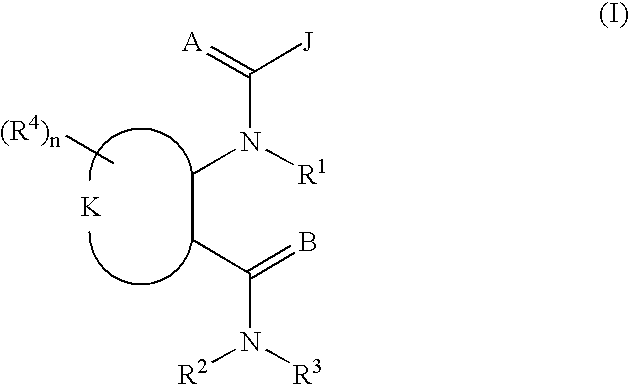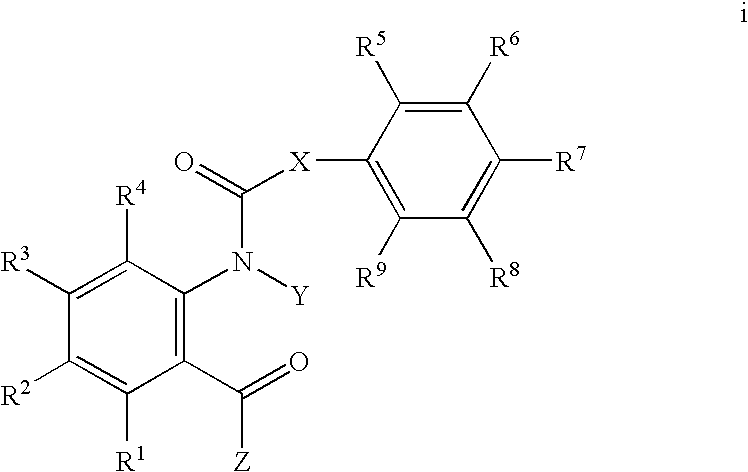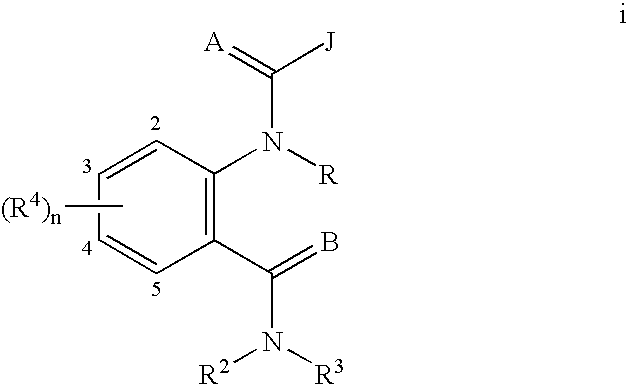Heterocyclic diamide invertebrate pest control agents
- Summary
- Abstract
- Description
- Claims
- Application Information
AI Technical Summary
Problems solved by technology
Method used
Image
Examples
example 1
Preparation of 5-methyl-N-(1-methylethyl)-4-[[4-trifluoromethoxy)benzoyl]amino]-3-pyridinecarboxamide
Step A: Preparation of ethyl 4-azido-5-methyl-3-pyridinecarboxylate
[0196] A slurry of 14.1 g (78 mmol) of ethyl 1,4-dihydro-5-methyl-4oxo-3-pyridinecarboxylate (prepared according to Horvath, G.; Dvortsak, P. J. Heterocycl. Chem. 1980, 359) in 30 mL of phosphorous oxychloride was refluxed for 1 hour. After cooling, the volatiles were removed with a rotary evaporator. The residue was poured into cold saturated aqueous sodium bicarbonate. Dichloromethane was added and the mixture was filtered through celite. The layers were separated. The organic layer was dried (sodium sulfate) and the solvent was removed with a rotary evaporator. The residue was dissolved in 150 mL of dimethylformamide. 15.2 g (234 mmol) of sodium azide was added. The mixture was heated at 95° C. for 1 hour. After cooling, the solvent was removed with a rotary evaporator. The residue was partitioned between ethyl a...
example 2
Preparation of 1-methyl-N-(1-methylethyl)-5-[[4-trifluoromethoxy)benzoyl]amino]-1H-pyrazole-4-carboxamide
Step A: Preparation of 5-amino-1-methyl-N-(1-methylethyl)-1H-pyrazole-4-carboxamide
[0204] 1.0 g (8.0 mmol) of 2-cyano-N-(1-methylethyl)acetamide (prepared according to the procedure of Cheikh et al J. Org. Chem., 1991, 56, 970) was combined with 3.1 mL of triethylorthoformate, 5 mL of acetic anhydride and 0.01 g of anhydrous zinc chloride. The mixture was refluxed for 1 hour. A distillation head was placed on the flask and the reaction was heated at 120° C. for 8 hours. After standing for two days the mixture was heated again for 12 hours at 120° C. for 12 hours. The volatiles were removed with a rotary evaporator. Ethanol was added and the volatiles were again removed with a rotary evaporator. This material was dissolved in 15 mL of ethanol. 0.34 mL (6.4 mmol) of methyl hydrazine was added. The reaction mixture was refluxed for 5 hours and then allowed to stand at room tempera...
example 3
Preparation of 4-methyl-N-(1-methylethyl)-3-[[4-trifluoromethyl)benzoyl]amino]-2-thiophenecarboxamide
Step A: Preparation of 7-methyl-2H-thieno[3,2-d][1,3]oxazine-2,4(1H)-dione
[0208] Phosgene in toluene (4.4 g, 20%, 8.88 mmol) was added to the sodium salt of 3-amino-4-methyl-thiophene-2-carbocyclic acid (1 g, 5.58 mmol) in water (17 mL) at 0 C. The mixture was allowed to warm to room temperature and was stirred for 1 hour. The mixture was filtered. After drying in vacuum the product was obtained as a solid 0.49 g (47%).
[0209] IR (Nujol®) 1785, 1696, 1580, 1513, 1236, 988, 918, 848, 826 cm−1.
[0210]1H NMR (DMSO-d6) δ 2.20 (s,3H), 7.88 (s,1H).
Step B: Preparation of 7-methyl-2-[4-(trifluoromethyl)phenyl]-4H-thieno[3,2-d][1,3oxazin-4-one
[0211] 4-(Dimethylamino)pyridine (0.66 g, 5.41 mmol) was added to the product from Step A in dioxane (10 mL). 4-(Trifluoromethyl)benzoyl chloride (1.13 g, 5.42 mmol) was added to the mixture and the mixture was boiled for approximately 3 hours. The m...
PUM
| Property | Measurement | Unit |
|---|---|---|
| Temperature | aaaaa | aaaaa |
| Temperature | aaaaa | aaaaa |
| Temperature | aaaaa | aaaaa |
Abstract
Description
Claims
Application Information
 Login to View More
Login to View More - R&D
- Intellectual Property
- Life Sciences
- Materials
- Tech Scout
- Unparalleled Data Quality
- Higher Quality Content
- 60% Fewer Hallucinations
Browse by: Latest US Patents, China's latest patents, Technical Efficacy Thesaurus, Application Domain, Technology Topic, Popular Technical Reports.
© 2025 PatSnap. All rights reserved.Legal|Privacy policy|Modern Slavery Act Transparency Statement|Sitemap|About US| Contact US: help@patsnap.com



